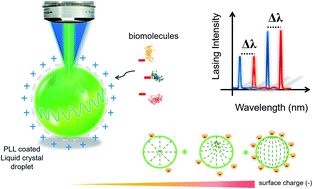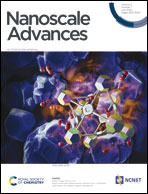Bio-electrostatic sensitive droplet lasers for molecular detection†
Abstract
Electrostatics plays a critical function in most biomolecules, therefore monitoring molecular electrostatic interactions at the biointerface can provide the basis in diagnosis and biomedical science. Herein we report a bioelectrostatic responsive microlaser based on liquid crystal (LC) droplets and explored its application for the ultrasensitive detection of negatively charged biomolecules. A whispering gallery mode (WGM) laser from positively charged LC microdroplets was designed as the optical resonator, in which the lasing wavelength shift was employed as the sensing parameter. We verified that molecular electrostatic changes at the biointerface of the droplet trigger a wavelength shift in laser spectra. Compared to a conventional polarized optical microscope, a significantly improved sensitivity and dynamic range by four orders of magnitude were achieved. Our results helped discover that the surface-to-volume ratio plays a critical role in the detection sensitivity in WGM laser-based microsensors. Finally, bovine serum albumin and specific biosensing were exploited to demonstrate the potential applications of microlasers with a detection limit in the order of 1 pM, thus offering new alternatives for ultrasensitive label-free biosensing and monitoring of molecular interactions.



 Please wait while we load your content...
Please wait while we load your content...